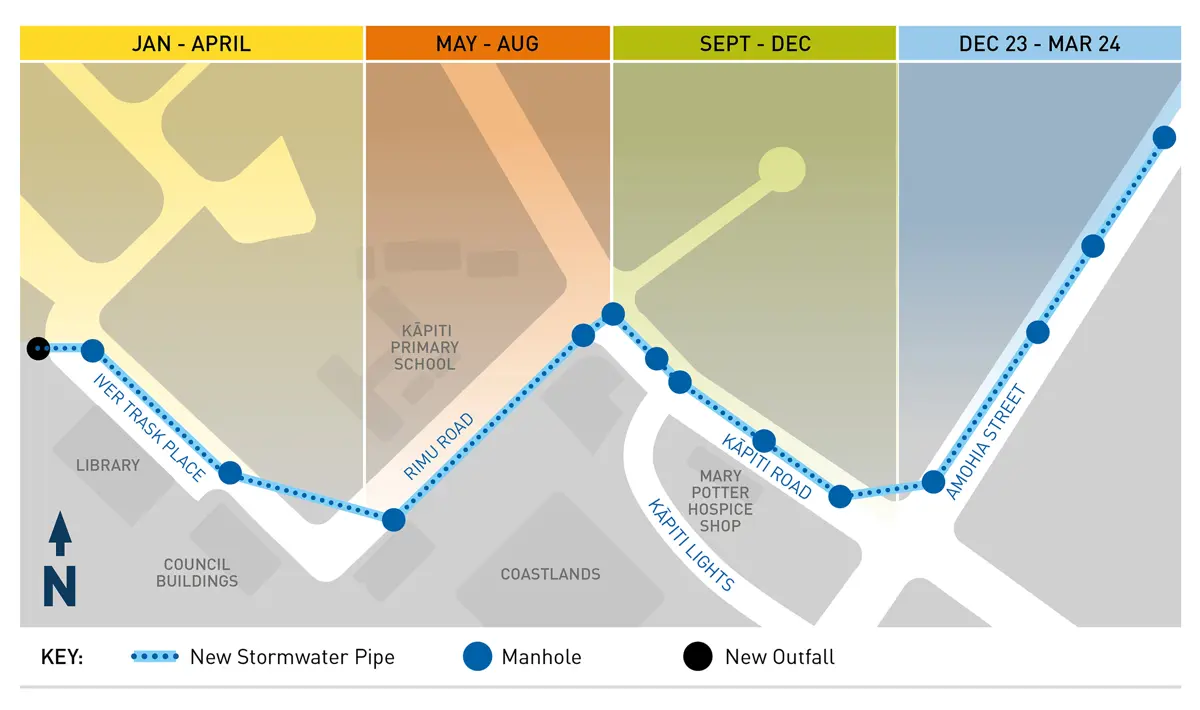- About Council
- Have your say
- Contact us
- Job vacancies
- Partners and advisory groups
- News and information
- Meetings
- Plans and reports
- Services and Requests
- Projects
Completed – Amohia Street stormwater
This project was archived on 6 June 2024
The Paraparaumu stormwater network upgrade began in January 2023. The upgrade involves installing almost 900 metres of larger stormwater pipes to reduce flooding in the Amohia and Ruahine Street catchment areas and help prepare our district to live with more water due to climate change.
Latest news
May 2024 – The stormwater upgrade is now finished.
Construction of the left-hand slip lane form Kāpiti Road to Amohia Street is due to be finished in June.
This infrastructure upgrade will help reduce flooding and prepare our district to live with more rain due to climate change.
See Stage 1d for more information.
Work programme
We’re installing approximately 805 metres of new, larger stormwater pipes in stages as funding allows.
Stage 1: Iver Trask Place to Amohia Street
The new stormwater pipe needs to be laid under the road to avoid other services in the area. The stormwater pipes and manholes will be installed at about 4 metres deep in places. Due to the high water table, we need to remove water from the work trench. This means pumps and generators will be running near work sites most of the time.
We'll have traffic management in place, but the work will cause some disruption to traffic around the work area.
Stage 1a: Outfall of the Wharemauku Stream along Iver Trask Place to Rimu Road – January–April 2023
Our first task was to build a new outfall structure in the Wharemauku Stream in Iver Trask Place. Work then progressed along Iver Trask Place in stages towards Rimu Road.
In April 2023 we began installing the new stormwater pipe under the south-east corner of Kāpiti Primary School’s field.
Stage 1b: Rimu Road from Iver Trask Place to Kāpiti Road – May–August 2023
We installed approximately 150 metres of new pipe and two manholes along Rimu Road towards Kāpiti Road.
The first stage required a full road closure of Rimu Road just north of Iver Trask Place while our contractors installed a large manhole in a trench five metres wide and six metres deep.
The other stages saw our contractors installing stormwater pipe along Rimu Road until they reach Kāpiti Road in August 2023. Detours have been in place and traffic flows will change as the work moves along Rimu Road.
On Kāpiti Road, we allowed for one right turn into Rimu Road, where a one-way lane was open to southbound traffic. The left turn from Kāpiti Road into Rimu Road was temporarily closed when works reach the intersection.
Stage 1c: Kāpiti Road to Amohia Street, September–December 2023
During September we'll install the stormwater pipe diagonally across the intersection of Rimu and Kāpiti roads, and then head east along Kāpiti Road towards Amohia Street.
Stage 1d: Amohia Street to near 65 Amohia St, December 2023–May 2024
This is the last stretch of the major Paraparaumu stormwater upgrade, with just 250 metres of pipe and five manholes left to install. Starting in January, our crew will install pipes and a manhole near 23 Amohia Street. We need to close the northbound lane on Amohia Street for this work, so a detour for northbound traffic will be in place during this time.
After the first manhole is installed, our worksite will be located in the middle of Amohia Street with traffic running on either side of it.
A detour for northbound traffic will be in place during this time. Please plan ahead and allow extra time for your journeys during these works. We appreciate your patience and cooperation as traffic management around the moving work site affects traffic flow in the area.

Background
The Amohia stormwater catchment is part of the wider Wharemauku Stream catchment, which drains from the hills behind Paraparaumu through the Wharemauku Stream to the sea. Our investigations showed three main areas of interest within the catchment:
- Several properties on and around Amohia Street have a history of flooding during heavy rainfall, with numerous properties at risk of habitable floor flooding to a level of more than 820 millimetres during a 100-year Average Recurrence Interval (ARI) storm.
- Ruahine Street floods in heavy rain due to runoff from upstream hill catchments. The volume of rainwater exceeds the capacity of the existing stormwater network. While most of this flooding is shallow overland flow, it does back up to a level of more than 1.3 metres deep behind the train line. The runoff flows overland, generally as shallow sheet flows, before reaching an open drain downstream of Tongariro Street.
- Several properties on Kāpiti Road and near the upstream open drain are at risk of habitable floor flooding during a 100-year ARI storm.
We've been investigating this issue for several years, and considered several options and routes before deciding on this plan to install larger stormwater pipes.